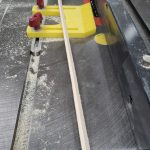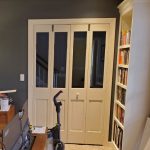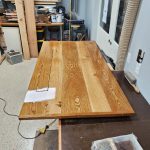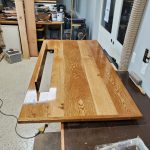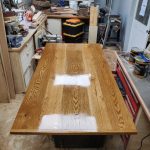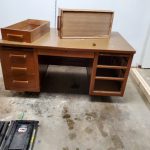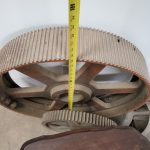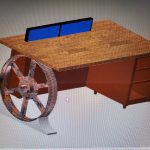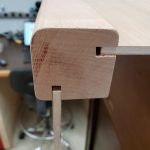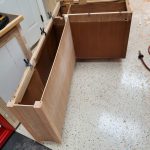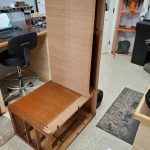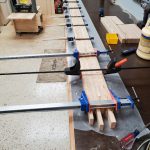Cubby Hole Toy Organizer
Another quick furniture project, this time a cubby hole toy organizer from maple plywood. The interior is 1/2″ and exterior 3/4″ with a 1/8″ back. Iron-on edge banding was applied/trimmed and then everything got several coats of water-based polyurethane. The holes are made to fit storage bins, the outer columns are slightly wider to accommodate hinges for doors that will be added eventually – the plan is for the doors to be busy boards over all 3 main sections, which may take some time. The center is open for now but may have shelves added.
Bookcase
Quick bookcase build project. First time using this technique, it’s just plywood with dados cut at each intersection. The main trick to this was planning out all dimensions in CAD first then making sure every cut was as accurate as possible, then everything went together like a puzzle and made solid glue joints. It took many rounds of filling, priming, and sanding to hide the plywood texture. After paint was complete I added off-the-self legs.
CNC Lake Coffee Table
Continuing with the first batch of wood from the sawmill and along with the other furniture changes it sparked the idea to make a new coffee table. The previous table had been passed-on from the previous owner of the previous house, nothing special about it, overdue for replacement. There’s a nearby lake I wanted to incorporate into the design, and by far the toughest part of this project became obtaining its bathymetric data. The entity that controls the lake was helpful with a records request but ultimately their best data was a medium resolution plot, shared via pdf. There were some hints from various navigation and fishing apps that better data might be out there, but after a lot of messing around with importing and converting this turned into a dead end. I eventually resorted to sending the pdf provided by the govt through an image vector tracing tool, followed by many hours of manual cleanup. This gave a single contiguous vector curve for each depth increment that I could then assign to a CNC machining operation.
I tested the CNC programming on a scrap piece of plywood before sending the oak slab through. The table is the full 4ft width of the CNC but wider than the CNC’s depth. To get around this problem I ran the carving on the middle section of the table before completing the full slab glue-up. When the full slab was together I traced the large radii using a yardstick as a compass and connected these with smaller corner radii. This outline was cut with a jigsaw before being belt sanded and rounded over with the router. Then final sanding and finishing. I cut two small sections of steel angle and secured them to the bottom of the table across the slab joints with screws in slotted holes. This will help hold the table flat while still allowing some seasonal wood movement. Last step was attaching some off-the-shelf hairpin type legs.
Side Table and Lamp
The first batch of wood from the sawmill was getting dry enough for use and we were planning to replace the den sofas; to go along with this change a side table would be needed. At the same time I also created a lamp that would house a smart speaker and act as a cover for the phone charging cable from below. A key consideration for this project was cable management – for the table, a 3-conductor cable is routed through the leg, allowing a power strip to be mounted under the table. The power strip has a phone charger, power to the lamp, and power for the smart speaker which all route up through the center of the table, hidden by the lamp. The lamp cord is also hidden within one of the lamp supports. A knob was cut on the CNC router to secure the lamp shade.
Louvered Generator Cover
The generator is still working great but as the side of the yard it’s in has become more polished (trees/undergrowth removed, grass planted, sidewalk added, trailer moved) the generator has started to stand out more. To help it blend back in I created some louvered panels to cover it. The louver design allows for plenty of ventilation from all sides. The panels consist of 1×4 slats secured into 1×4 ends with angled grooves cut via dado stack. The panels corners are joined together at 4×4 posts. The rear panel has a cutout for refueling, the top has a cutout for the exhaust flap (with flashing for heat protection) and half of the front folds down for control panel access.
I also made a similar but much smaller cover to go over the top of the plastic service dome for our underground propane tank.
Glass Bi-fold Doors
The home office has some bifold doors connecting it to the foyer. Normally I’d like to leave these doors open since it allows light & visibility to the front door, but that would also allow cats to enter the office (usually at the worst times). The solution seemed to be changing to bifold doors with glass panels, however these are very expensive. Since the existing doors were already good quality solid wood though, a good compromise seemed to be modifying them to add glass. I was able to find tempered glass for a reasonable cost online, so I went ahead with this project. Tempered glass is the key since it will break into small (less dangerous) pieces, it’s a code requirement for doors in most locations. The process went as follows:
- Cut a middle section out of the panels on each door. This allowed room for the next step.
- Pull the remnants of the panel edges out of the groove in each door frame.
- Route one side of the door frame flush with the bottom of the groove.
- Install glass panel.
- Make trim piece to hold glass in place, this piece basically replaces the piece of the original groove edge that was routed away.
- Carefully tack trim in place.
- Fill/Sand/prime/paint trim pieces.
Custom Desk – Complete
I cut the trap door in the desktop, secured it back with some neat invisible hinges, and got it all assembled.
Custom Desk – Desktop
Continuing with the desk project, this weekend I built the desktop. I first planed down a few more pieces of the oak tree I cut down and dried last winter. This was supplemented with a few pieces of oak from a local hardwood store. I ran every piece through the table saw to get the edges straight, and then I laid the pieces together and perfected the joints with a hand plane. Once all the joints aligned perfectly I glued and clamped the pieces together with pipe clamps. Once the glue dried I cut the ends to length and added ends, making sure that the two outer attachments were slotted to allow for expansion/contraction.
There was some unavoidable variation in the joints across the top surface from the glue-up and this was leveled out with a hand power planer. The planer marks were then leveled with a belt sander and the belt sander scratches were removed with a orbital sander. I finished it off with stain and then applied polyurethane with a roller while using a torch to pop bubbles. The planing steps created a ton of dust so I didn’t get any in-progress pictures, here’s the result:
Next I’ll cut the trap door for the monitors and give it a final sanding and 2nd coat of polyurethane before attaching it to the desk.
Custom Desk – Design & Build Start
The office project is coming along well and the last major missing piece is a desk to replace the table we’ve been using.
Before starting this project we planned that the cabinets would cover the room’s exterior walls between the windows and we also left space on the interior wall for misc stuff (file cabinet, chair, etc). This left the center of the room largely open and it made sense to have the desk there. This arrangement provides some advantages: #1 sitting at the desk in the center allows facing out towards a window with a view up the driveway instead of just looking directly at an interior wall and #2 any screens on the desk will face an interior wall instead of the windows, minimizing glare.
Unfortunately the desk-in-the-center arrangement has one big drawback in that having monitors placed on the desk essentially forms a ‘wall’ of sorts in the room. Normally I wouldn’t care about this so much, but the office is directly adjacent to the foyer with a double-width door opening between the two – so it needed to look as good as it functions. The solution to this problem is to hide the monitors in the desk with a motorized lift mechanism.
We found a desk at goodwill to use as the starting point – the base is good quality hardwood but the top is/was a laminate slab that I’ll replace. We’ve also had a large gear waiting for the right project to come along. The plan is to remove one of the desk’s towers, replace it with the gear, and then make use of the existing back panel of the desk to enclose some space for the monitors.
I started with disassembly of the desk, and then I copied two corner pieces and added some 1/4″ plywood to form the monitor compartment. The new parts are made from Cherry which seems to be an OK match for the existing wood.
Next up I need to add some more internal structure to the monitor compartment then strip/sand the desk exterior and begin on the lift mechanism.
Oak Butcher Block Counter
At the end of last year I replaced the cabinet doors in our mudroom. Since we wanted to swap from half-overlay doors to inset doors and from raised panel style to shaker style, it make more sense to build new doors than to rework the existing ones. The new doors were to be painted, so I used poplar rather than ‘waste’ the oak from the existing doors. All this to say, I’ve had a big pile of scrap oak sitting around from the old mudroom doors waiting for the right project to come along.
Fast forward to present day, and I’ve started building cabinets for the office. These will also be painted, so are mostly made of poplar and cabinet ply. One section of the cabinets will be a hutch with some counter space. After considering counter options for a while it eventually occurred to us to use the scrap oak to construct a butcher block for the counter. In addition to the scrap oak I also had the oak from the saw milling tests that could be used to ensure coverage.
To start the build I sent all the scrap oak pieces through the planer to remove the stain/varnish layer on each side, and then I ripped down everything that wasn’t already 1.5″ wide (though most pieces already were). There were a few different thicknesses involved since the wood from the door panels was a little thinner than the wood from the door frames, and the wood from saw milling was a little thicker than the rest. The variation in thickness isn’t a problem though as long as all wood pieces of the same thickness are kept on the same row. It is very important that all pieces in the same row are planed to the exact same thickness to ensure no gaps.
I laid everything out first to make sure the pattern would cover the size needed. For the edge that would face out I used a piece of store-bought oak that I had leftover from making the shop work benches, this piece was long enough to cover the entire length of the counter so that no joints would be on the edge and so that the edge would have a consistent thickness. With the layout confirmed, I then I glued up about 1/3 of the width in 3 sessions before then gluing and clamping those sections together. I used a solid roller/brayer to spread the glue, all together about 1/2gal (!) of glue was required.
After the glue dried I planed the top flat with a handheld power planer and cut the ends to length. I then further fine tuned the flatness with a belt sander before a final sanding with an orbital sander. The slab then got a medium stain (Early American) to even out the red oak’s color variation a bit, followed by wipe-on poly.
This is a situation where a similar slab could be bought for less after considering the time spent. It’s neat though to have a custom piece that encapsulates some history of the house as well as solving the ‘problem’ of getting rid of the scrap oak (I’d never throw it away and it was taking up a lot of room); so altogether I’d say it was worth the time spent. Planing created a mountain of sawdust and before the next big project involving the planer I need to make a dust collector connection for it.



































